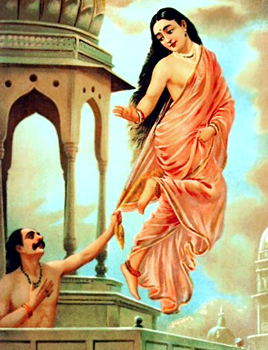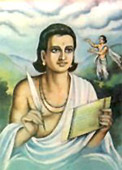 Ballad Poetry of Rig Veda is contained in a number of verses scattered across the length and breadth of the work. The most famous of these is a poem of 18 stanzas, consisting of a dialogue between Pururavas and Urvasi. Pururavas is a mortal, Urvasi a nymph (Apsara). The divine beauty lived on earth for four years as the wife of Pururavas until she became pregnant by him. After that she vanished "like the first of the dawns." He went out to seek her. At last he found her, playing with other water-nymphs, in a lake. That is about all that can be gleaned from the obscure verses, from the dialogues between the deserted one and the goddess who is romping about in the pond with her playmates. Fortunately this ancient myth of the love of a mortal king for a divine maiden is also preserved in other portions of Indian literature, and thus we can, to a certain extent, complete the poem of the Rig Veda. Whether and How Pururavas is reunited with his beloved is not quite clear either in the Rig Veda or in the Galapatha Brahmana. It seems that he becomes transformed into a Gandharva and attains heaven, where at last the joy of re-union is his.
Ballad Poetry of Rig Veda is contained in a number of verses scattered across the length and breadth of the work. The most famous of these is a poem of 18 stanzas, consisting of a dialogue between Pururavas and Urvasi. Pururavas is a mortal, Urvasi a nymph (Apsara). The divine beauty lived on earth for four years as the wife of Pururavas until she became pregnant by him. After that she vanished "like the first of the dawns." He went out to seek her. At last he found her, playing with other water-nymphs, in a lake. That is about all that can be gleaned from the obscure verses, from the dialogues between the deserted one and the goddess who is romping about in the pond with her playmates. Fortunately this ancient myth of the love of a mortal king for a divine maiden is also preserved in other portions of Indian literature, and thus we can, to a certain extent, complete the poem of the Rig Veda. Whether and How Pururavas is reunited with his beloved is not quite clear either in the Rig Veda or in the Galapatha Brahmana. It seems that he becomes transformed into a Gandharva and attains heaven, where at last the joy of re-union is his.
 The story of Pururavas and Urvasi has often been retold in India: it is briefly hinted at in the Kathaka belonging to the black Yajur Veda, it is retold in exegetic works attached to the Vedas, in the Harivamsa Parva, an appendix to the Mahabharata, in the Vishnu Purana and in the book of tales Kathasaritsagara, and no less a poet than Kalidasa has founded one of his immortal dramas on it. From the circumstance that, in spite of all efforts to bring the verses of the Rig Veda into unison with the later narratives and to utilize the latter in the elucidation of the Rig Vedic poem, there is still so much that is obscure and unexplained in these verses, we see how very much earlier the Rig Veda is than any other known work of Indian literature.
The story of Pururavas and Urvasi has often been retold in India: it is briefly hinted at in the Kathaka belonging to the black Yajur Veda, it is retold in exegetic works attached to the Vedas, in the Harivamsa Parva, an appendix to the Mahabharata, in the Vishnu Purana and in the book of tales Kathasaritsagara, and no less a poet than Kalidasa has founded one of his immortal dramas on it. From the circumstance that, in spite of all efforts to bring the verses of the Rig Veda into unison with the later narratives and to utilize the latter in the elucidation of the Rig Vedic poem, there is still so much that is obscure and unexplained in these verses, we see how very much earlier the Rig Veda is than any other known work of Indian literature.
Yet another splendid example of Rig Vedic ballad poetry is the Suryasukta. This particular hymn describes the marriage of Surya (the sun-daughter, as the dawn is here called) with Soma (the moon), at which the two Asvins were the match-makers. This hymn consists of 47 verses, which re somewhat loosely connected. The verses nearly all refer to the marriage ritual, and most of them, as is known from the Grhyasutras, the manuals of domestic ritual, were used also at the marriage of ordinary mortals. Yet it does not seem that the verses have been merely compiled from the ritual, as is the case with some of the funeral hymns, so that they would have to be regarded as a kind of compilation of all the benedictions used in the marriage-rites, like a chapter in a prayer-book. It is much more probable that it is an ancient ballad describing the marriage of Surya partly in narrative stanzas, partly in addresses to the Asvins and Surya, and partly by the insertion of the mantras (benedictions, incantations) recited at the various stages of the carriage ceremony. Some of the marriage benedictions have more of the character of magic formulas. Among them we find charms against the evil eye and other pernicious magic, by means of which the bride could injure her future husband, as well as exorcisms by means of which demons, which lie and wait for the bride, are to be scared away. These magic formulas by no means stand alone, for there are, besides, about thirty magic songs in the Rig Veda. Some of these are benedictions and formulas for the healing of various diseases, for the protection of the embryo, for warding off the effects of bad dreams and unfavourable omens, while others are incantations for the scaring away of witches, for the destruction of enemies and malevolent wizards, or magic formulas against poison and vermin, verses for the supplanting of a rival. Besides this one can also find a blessing on the field, a charm for the prosperity of cattle, a battle charm, a charm for inducing sleep, and so on.
Thus discussed are some of the ballad poetry works found in the Rig Veda.



















